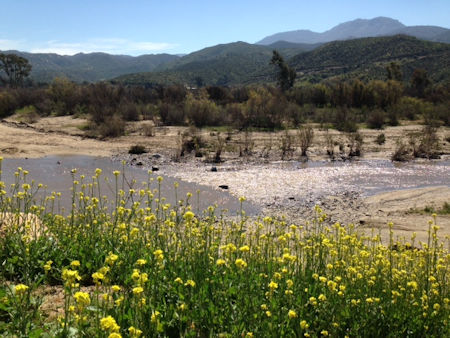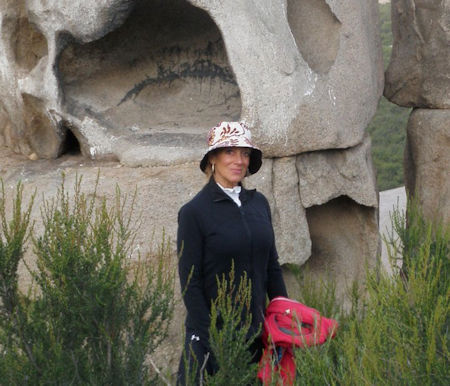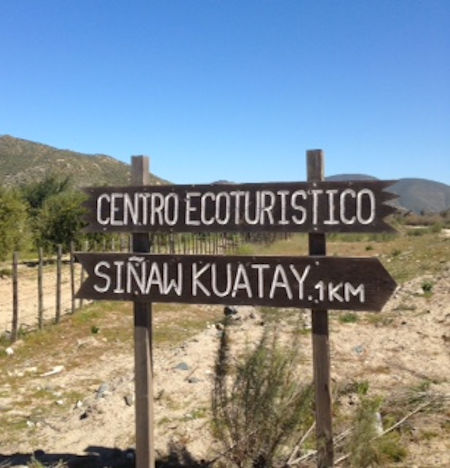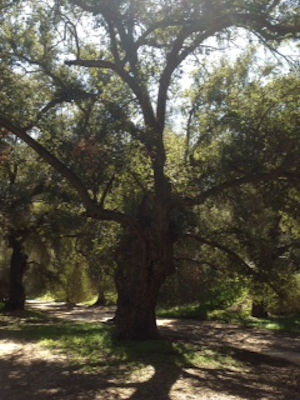 |  |
By Martina

The lonely wail of the coyote breaks the silence of the night. The sacred mountain is bathed in full moon light and dark shadows move around a night fire. The shamans have come to the sacred mountain they call Kuchumaa. These ancient foothills strewn with granite boulders hold an energy and a power of which the early Kumiai Indians were well aware. The land they walked spoke to them, and they honored all living things, knowing themselves as a part of the whole of life. They were nourished by the great oak trees and wildlife, their world clothed them and they knew the healing of the wild plants. They built their homes of river reeds and tree branches and when they needed to move, they burned them to the ground. They left a very small footprint on the land, only depressions in the granite stones where they ground the acorns of the oaks. They left no written language behind, only crude cave paintings. They moved with the seasons and recognized life in all things, giving thanks to the Great Spirit, Father Sky and Mother Earth for their very life. They had no idea of ownership of the land for they were in true relationship with where they lived. To them the land was endless and stretched from what is now southern California, as far north as Hemet, and south to Ensenada. As they did not have a written language to write their name, it appears as Kumeyaay in California and in Spanish is spelled Kumiai in Baja California.

Today, the sacred mountain, Mount Kuchumaa rises 4,000 ft. and straddles the border. Its name means, “The Uplifting Place.” On the Baja California side, Rancho La Puerta, the lush wellness and spa resort, takes advantage of the sacred grounds. They take great care of their part of the 3000 acres. Guests and staff of Rancho La Puerta have a special 4-mile trail to the top which is well maintained by the insightful stewardship of the Rancho. At the top, guests are rewarded with a spectacular view and the intriguing Skull Rock, a huge granite boulder worn smooth by wind and rain. The ranch property is closed to the general public, but at the far eastern edge is “Parque Professor,” which is open to the public and every year creates a dazzling Day of the Dead celebration.
The Indian tribes have not been cut off from their sacred mountain and still gain access to hold their special ceremonies. Oral tradition tells of important shamans who took their initiates there for instruction. When a boy approached manhood, he had to undergo initiations and then was sent on a pilgrimage to the top for a vision. In their eyes, Kuchumaa was the womb of the world, the place from which creation sprang. To this day, the tribes’ few remaining elders and shaman continue to hold ceremonies on the summit. For these people, the peak is a special place for acquisition of knowledge, vision quests, and purification ceremonies. Contemporary Native Americans most frequently use Kuchumaa during periods of full moons and equinoxes. During these times they pray for renewal of Mother Earth and they pray for peace.
Leaving behind the sacred mountain, we set out to San Antonio Necua, a Kumiai villages that welcomes visitors on the weekends. Highway #3 cuts through the ancestral lands. It is a fantasying muse to consider what it would have been like if we were one of the first people who walked through this harsh but beautiful landscape. There would be no towns along the way; no places to stop for water, unless you knew the cactus that was best to cut for liquid refreshment.

After an hour drive, we enter into the east end of the Guadalupe Valley. Here in this region it is recorded the Kumiai have lived for over 1300 years, but the Kumiai Nation goes back 600 generations.
They roamed freely throughout this beautiful valley. However, with immigrants from Russia, China, Italy, and France, as well as the Mexican farmers, the Kumiai were pushed further back and further into the hills. Now the Guadalupe Valley is a thriving wine region with lovely wineries and vast vineyards gracing the hills.
We take the turn at the entrance for LA Cetto winery and pass through the vast vineyards; then on past Dona Lupe. Just beyond the sign, Sinaw Kuatay, the pavement ends. This is where the adventure begins. If there has been rain, you might find yourself fording a shallow stream. Most passenger cars will have sufficient clearance. Rain in the winter and early spring is infrequent, so generally this is not an issue in summer months. The first thing to notice are the majestic old oaks and deep shade on hot summer days. The village is a humble pueblo of small homes, a school, small store with simple supplies and a rodeo ground. What stands out is the newer addition of a museum, artisan building and meeting hall. The newer ceremonial arena is covered in shade cloth with concrete bleachers and a dance floor. All are welcomed on weekends to meander through stone walkways lined with native plants and cactus. There are small wooden huts as examples of how the people found all they needed in nature to build a simple home. There was no need for anything more permanent. I could not help but feel the freedom of this way of life. Entering the museum there is a nice collection of artifacts and more recent pictures of the tribal council as well has the cowboys who are still active today. Stepping back out into the bright sunshine, the peacefulness is palpable. Most weekends have only a few visitors. I chose to sit in the shade to have lunch while listening to the ancient winds that still blow through the trees. The winds have seen the major changes the Kumiai have had to make in order to survive.

There is one day of the year when the village fills to capacity. Every year on June 13th an important cultural gathering of surrounding tribes takes place. The Pai-Pai, Cucaph, Kiliwa and Kumiai join together to honor their way of life. The artisans bring their fine baskets and unique pottery as well as many feathered and beaded crafts. Traditional dancers and bird singers with their immense gourd rattles weave their life in songs which have been handed down through the generations. One can take part in a guided nature hike and learn about the native plants and their uses. In the outdoor kitchen women prepare the afternoon meal in huge pots over the open fire and all are welcomed to partake, as in early tradition when meals were shared with visitors. To conclude this day of celebration a bond fire is set and roaring flames leap into the night sky. It is thrilling to see the immense blaze and having participated throughout the day’s celebration, a deeply human core is touched in us. After 600 generations, they are here to gift us something that is truly important in these times of rapid complexity and separation from nature. They show us how to live simply, be in right relationship with Mother Earth and hear the ancient winds move through the trees.
Martina's email: mteomaya(at)gmail.com